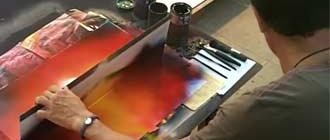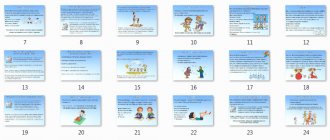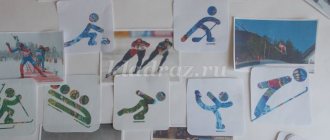Didactic games in art classes in kindergarten
Didactic games for preschoolers
Didactic games in art classes in kindergarten"
Author: Matveeva Evgenia Aleksandrovna, teacher at MDOU - kindergarten No. 16 "Malyshok", Serpukhov, M.O.
Sometimes it can be very difficult to explain some material to a child. And of course it’s even more difficult to explain it so that he remembers it. And here didactic games come to the aid of the teacher. They are used in the educational process from the very beginning of a child’s learning to draw. I bring to your attention examples of such games that I use in my work. 1. Game “Colored baskets”
The first game is used with very young children and is called “Colored Baskets”.
Purpose of the game: the game is aimed at learning colors by children 2.5-3.5 years old, memorizing the names of primary colors, developing the speech skills of preschoolers, developing observation and memory. Progress of the game: children are asked to collect mixed up objects in baskets, the child draws any card, but he must put it in a basket of the same color, while loudly calling out the color and the object he chose.
2. Game “Bottom of the Sea”
Purpose of the game: development of artistic composition skills, development of speech, logical thinking, memory. A very common game that can be used not only in art activities, but also in other educational areas. The children are shown the seabed (empty), and it must be said that all the sea inhabitants wanted to play “Hide and Seek” with us, and in order to find them we need to guess riddles about them. The one who guessed correctly puts the resident in the background. The result is a complete composition. The teacher motivates children to perform visual activities. (Good to use with middle and older groups). In the same way, you can study with children other themes of plot compositions: “Summer Meadow”, “Forest Dwellers”, “Autumn Harvest”, “Still Life with Tea”, etc. You can invite several children to the board and ask them to make different compositions from the same objects. This game develops intelligence, reaction, and compositional vision.
3. Game “Painted Horses”
When consolidating knowledge of folk paintings or when conducting monitoring in senior and preparatory groups, you can use this simple game.
Goal: to consolidate knowledge of the main motifs of Russian folk paintings (“Gzhel”, “Gorodets”, “Filimonovo”, “Dymka”), to consolidate the ability to distinguish them from others, to name them correctly, to develop a sense of color. Progress of the game: the child needs to determine in which clearing each of the horses will graze, and name the type of applied art based on which they are painted.
4. Game “Magic Landscape”
One of the most difficult topics is, of course, the study of perspective in a landscape - distant objects seem smaller, near ones larger.
It is also more convenient to use the game for this. Purpose of the game: to teach children to see and convey the properties of spatial perspective in drawings, to develop the eye, memory, and compositional skills. Progress of the game: The child needs to place trees and houses in pockets according to their size according to their perspective distance. (preparatory group).
5
. Game "Collect a landscape"
Using the example of a landscape, it is also convenient to develop a sense of composition and knowledge of natural phenomena.
To do this, it is convenient to use this didactic game. Purpose of the game: to develop compositional thinking skills, consolidate knowledge of seasonal changes in nature, consolidate knowledge of the concept of “landscape,” develop observation and memory. Progress of the game: the child is asked to create a landscape of a certain season (winter, spring, autumn or winter) from a set of printed pictures; the child must select objects corresponding to this particular time of year and, using his knowledge, build the correct composition.
6.Game “Arrange and count the nesting dolls”
Purpose of the game: to consolidate knowledge about the Russian nesting doll, develop the ability to distinguish this type of creativity from others, develop ordinal counting skills, eye, and reaction speed.
Progress of the game: Leaves with drawn silhouettes of nesting dolls hang on the board, three children are called and they must quickly arrange the nesting dolls into cells and count them.
7. Game “Matryoshkin’s sundress”
Purpose of the game: to develop compositional skills, consolidate children’s knowledge about the basic elements of painting a Russian nesting doll, and consolidate knowledge of Russian national clothing. Progress of the game: Silhouettes of three nesting dolls are drawn on the board, the teacher calls three children in turn, they each choose to wear their own nesting doll.
Each of these games can be drawn by yourself or made using a computer and a color printer.
We recommend watching:
Didactic games with sand for children 3-4-5 years old. Didactic games (verbal) for children 5-6 years old. Didactic game for children 6-9 years old. Happy vegetable garden Consultation for parents “Drawing houses.” Junior group
Similar articles:
Didactic game “Collect a caterpillar” for children 5-6-7 years old
Didactic game “Find a Pair” for children 3-4 years old
Didactic game "Flowers" for children 5-6-7 years old
Didactic game for the development of fine motor skills of children 3 – 7 years old
Didactic game for preschoolers. Formation of ideas about time
Progress of the game
The teacher places objects of different colors (vegetables, dishes, pencils, etc.) along the edge of the table.
. The doll Katya comes to visit the children. She wants to match her red bow with objects of the same color. Children come up one at a time and name the object and its color: red tomato, red pencil, etc. If the answer is correct, Katya doll nods her head approvingly, and the child puts the object in her purse ; if the answer is incorrect, then Katya turns away.
2. Game “Such different handkerchiefs”
Didactic task . Strengthen children's ability to draw straight lines in different directions.
Game task. Decorate handkerchiefs for Andryusha and Seryozha.
Game rules. Don't mix up gifts.
Progress of the game
1st option
The teacher offers the children a hat, scarf and mittens. The children decorate their clothes with the proposed geometric shapes according to the teacher’s instructions: “Decorate the scarf with blue geometric shapes.”
2nd option
The teacher suggests decorating clothes with certain geometric shapes: “Decorate the mittens with circles”
6. Didactic game “Rainbow round dance”
Target:
1. To consolidate children's knowledge of the colors of the rainbow in their sequence.
2. Exercise your ability to talk about the color of sundresses and kokoshniks in nesting dolls.
Game material:
1. A long envelope with seven nesting dolls, which have cut out silhouettes of sundresses and kokoshniks.
2. 7 rectangles of paper of all colors of the spectrum (red, orange, yellow, green, blue, indigo, violet)
.
H. Picture of a rainbow
Progress of the game
The teacher shows the children pictures with vases and suggests making 2 bouquets: one of warm-colored flowers, which resembles the color of fire. And the other - cold tones, which are similar to the color of the sky, water, ice floes.
The teacher sets up a flannelgraph, on which he attaches flower heads in disarray. He calls two or four children to perform the exercise. Children find the right flowers and attach them to the ends of the stems, then talk about their bouquets, for example: “I made a bouquet of red, orange and yellow flowers, My bouquet of warm-colored flowers” Or “My bouquet of cool-toned flowers - blue, blue and purple"
2. Didactic game “Dress the dolls for a walk”
Target:
1. Teach children to find shades darker or lighter than a given color.
2. Teach children to talk about clothes for dolls, using in their speech complex sentences like “The hat on the doll is darker, and the boots are lighter than the coat.”
.
Game material:
1. Panel with four dolls in green, red, brown and blue coats. The dolls' hair and stockings are cut out onto flannel or velvet paper.
2. 8 hats and 8 pairs of boots. Half of the hats and boots are lighter shades than the coat, the rest are darker. The back of the caps and coats are glued with velvet paper or flannel.
Progress of the game
The teacher hands out cards to the children, and places 16 squares of four different shades in the middle of the table. Invites children to select 4 squares of the same colors as the objects on their cards and arrange them in the corresponding cells. Then he asks to tell what shades of what colors were used by the artist. For example: “All my objects are yellow, but in different shades. Lemon is light yellow, sunflower is bright yellow, pear is dark yellow.” Or: “I have blue objects, but in different shades. The darkest blue is plum, the brightest is cornflower, the lightest is bell.”
5. Didactic game “Decorate a hat, scarf, mittens”
Target:
1. To consolidate children’s knowledge about the main colors of the spectrum.
2.Introduce geometric shapes: circle, square, triangle.
Progress of the game
The teacher shows the children a coat. He asks what color the coats are on the dolls. Draws children's attention to the fact that the dolls are not yet fully dressed for a walk: they need to put hats and boots on them. He puts out a flannelgraph, wearing a cap and boots. He suggests dressing the doll in a red coat, choosing boots for her that are lighter than the coat, and a hat that is also lighter than the coat.
The called child chooses a hat, boots and “puts them on”
them on the doll, and then tells how she is dressed: “The doll is wearing a red coat. The cap and boots are also red, but lighter than the coat.”
Next, the teacher invites three children to the table at once - they select hats and boots for the rest of the dolls.
Then the tasks are modified: three children are asked to put darker hats and boots on the dolls than coats.
At the end of the game, children select hats that are darker and boots that are lighter than the coat, and vice versa (On the doll, the cap is darker and the boots are lighter than the coat)
.
3. Didactic game “Let’s clarify the color of objects”
Target:
1. Exercise children in distinguishing the colors of objects; learn
distinguish similar colors: red - orange, red - pink, pink - lilac, blue - light blue, etc.
2. Practice agreeing adjectives with nouns: blue forget-me-not.
3. Practice composing sentences with the conjunction a: the tomato is red, and the carrot is orange.
Game material:
1. Tables with images of two plants that are similar in color: tomato and carrot, poppy and rose hip, forget-me-not and back, rose and lilac, cornflower and eggplant. One plant on each table is depicted in color and covered with a piece of paper glued on top, the other is cut out in silhouette, and there is an envelope at the back into which a colored paper rectangle is inserted.
2.Colored paper rectangles: red, orange, pink, lilac, blue, blue, violet.
4. Didactic game Colored Lotto (board game)
Target:
To develop in children the ability to distinguish 4 shades of the same color, to name objects of the same color, but different shades.
Game material:
1. 4 cards, divided into 4 cells, which depict objects of the same color, but different shades: red - star, flag, flower, cherries; yellow – lemon, sunflower, turnip, pear; green - grapes, spruce, plant leaves, cucumber; blue – cornflower, bell, plum, balloon.
2. Paper squares of the same colors and shades.
Progress of the game
The teacher puts it in front of the children on a board (easel)
an envelope with
images of nesting dolls and says: “Seven matryoshka girlfriends staged a round dance and saw a seven-color rainbow in the sky.
They wanted to be like her and decided to wear sundresses of the same colors, but they forgot in what order the colors in the rainbow are located. Do you, children, remember? Here are seven rectangles the same colors as the arcs in the rainbow. Let's make a rainbow round dance of nesting dolls." Children take turns inserting one colored rectangle into the envelopes. Then the teacher asks if the colors of sundresses and kokoshniks were chosen correctly, in the same order as in a rainbow. To check, he shows a picture of a rainbow and asks to tell how the nesting dolls are dressed in a round dance: “The first matryoshka is in a red sundress and kokoshnik, the second is in orange, the third.” etc. Summing up, the teacher draws the children’s attention to the gradual transition of color from red to purple.
7. Didactic game “Match cups to saucers”
Target:
Teach children to distinguish several shades of pink, purple and orange and use the names of shades of color in speech; introduce different ways of distinguishing shades of the same color.
Game material:
Set of cloth, saucers and cups of different colors and shades (cut out of paper and pasted on cardboard)
. You can make slits in the saucers to insert cups.
Progress of the game
The teacher says that an artist he knows decided to draw two of his friends, Seryozha and Andryusha (shows the drawing)
.
They have beautiful clothes - bright, colorful, but the artist ran out of paint early, and he could not paint the handkerchiefs that are visible from the pockets of his friends. The artist asks the children to color Seryozha and Andryusha’s handkerchiefs. The teacher gives the children sheets of paper ( “handkerchiefs”)
and they paint them: Andryusha likes striped handkerchiefs, and Seryozha likes checkered ones. After the children draw the handkerchiefs, they must not mix up: Andryusha is a boy in a red jacket, Seryozha is in a blue one. Children take ready-made
“handkerchiefs”
and give them to their friends
(striped ones for Andryusha, checkered ones for Seryozha)
.
3. Game "Kolobok"
Didactic task . Strengthen children's ability to roll a ball and a strip from a lump of plasticine; develop the ability to see the beauty of color against the background of different objects.
Game task. Make friends for a bun.
Game rules. Make a bun and a path of the same color.





